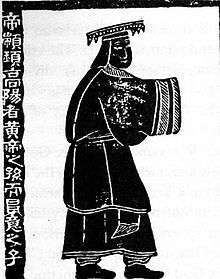Zhuanxu
| Zhuanxu | |
|---|---|
 Emperor Zhuanxu. Rubbing of mural bas-relief from the Wuliang tomb shrines: Han Dynasty. | |
| Successor | Ku |
| Parent(s) | Changyi |
| Relatives |
Ku (cousin) Yellow Emperor (grandfather) Leizu (grandmother) |
Zhuanxu (Chinese: trad. 顓頊, simp. 颛顼, pinyin Zhuānxū), also known as Gaoyang (t 高陽, s 高阳, p Gāoyáng), was a mythological emperor of ancient China.
In the traditional account recorded by Sima Qian, Zhuanxu was a grandson of the Yellow Emperor who led the Shi clan in an eastward migration to present-day Shandong, where intermarriages with the Dongyi clan enlarged and augmented their tribal influences. At age twenty, he became their sovereign, going on to rule for seventy-eight years until his death.
Family
Zhuanxu was the grandson of the Yellow Emperor and his wife Leizu by way of his father Changyi. His mother was named Changtsu according to Sima Qian, Niuqu according to the Bamboo Annals.
Zhuanxu was subsequently claimed as an ancestor by many of the dynasties of Chinese history, including the Mi of Chu and Yue, the Yíng of Qin, and the Cao of Wei.[1]
Reign
Zhuanxu was held by many sources to be one of the Five Emperors.
According to Sima Qian's Records of the Grand Historian, upon the passing of the Yellow Emperor, Zhuanxu's uncle Shaohao never actually reigned as king, as in other reports. Rather, Gaoyang was chosen as the tribe's new leader, with the regnal name Zhuanxu, in preference to his father and all his uncles.[4] Zhuanxu defeated Gonggong, a descendant of the Emperor Yan.
However, the account in the Bamboo Annals states that Zhuanxu became an assistant to his uncle, Emperor Shaohao, at the age of ten, and became king in his own right at age 20.
He made contributions to a unified calendar, astrology, religion reforms to oppose shamanism, upheld the patriarchal (as opposed to the previous matriarchal) system, and forbade close-kin marriage. The Bamboo Annals also credit him with composing one of the earliest pieces of music, known as "The Answer to the Clouds".
Zhuanxu was succeeded by his cousin, Shaohao's son, Ku. In the Shiji, he criticized one of his sons for being a dullard. Since only two sons were named, it might have been Gun, father of Yu the Great or Qiongchan, the ancestor of Shun. Yao had also criticized Gun for being incompetent and ruinous. The Shiji labelled Qiongchan an insignificant commoner though it does not mention how he fell from grace. He also had eight unnamed sons of good repute that later worked for Shun.
Calendar
The Bamboo Annals record that in his 13th year of reign, Zhuanxu "invented calendric calculations and delineations of the heavenly bodies".
Since Zhuanxu was claimed as a founder of the Qin dynasty, his name was taken for inauguration of the new calendar system by Shi Huangdi.
Mythology
Zhuanxu is also mentioned as a god of the Pole Star and as the father of Taowu.
Potential Connection with Longshan Culture?
Zhuanxu is commonly associated with the extremely important myth of the separation of the Heaven from Earth. According to the Lu Xing chapter of Shang Shu
"We are told that the Miao ... created oppressive punishments which the people into disorder. Shang Di, the Lord on High ... surveyed the people and found them lacking in virtue. Out of pity for those who were innocent, the August Lord .. had the Miao exterminated. 'Then he charged Chong and Li to cut the communication between Heaven and Earth so that there would be no descending and ascending." After this had been done, order was restored and the people returned to virtue." [5]
Several Chinese mythologists interpreted this myth as a representation or symbolization of the increasing social stratification occurring. Before the 'separation of Earth and Heaven', in Yangshao culture, it was open to every household that had or could hire a shaman. However, during Longshan culture, shamans could only be hired by a few people, suggesting a monopoly of the ability to ascend to and descend from Heaven. In this sense, this myth marks the start of social stratification on China's rise to civilization. [6]
References
- ↑ This last claim was made by the Wei Shu and Tung Pa but attacked by Chiang Chi, who claimed the Tian (田) were descended from Zhuanxu instead.[2][3]
- ↑ Howard L. Goodman (1998). Ts'ao P'i Transcendent: the Political Culture of Dynasty-Founding in China at the End of the Han (illustrated ed.). Psychology Press. p. 70. ISBN 0966630009. Retrieved 1 Apr 2012.
- ↑ House of Chinn. "History".
- ↑ Asiapac Editorial (2006). Great Chinese emperors: tales of wise and benevolent rule (revised ed.). Asiapac Books Pte Ltd. p. 9. ISBN 9812294511. Retrieved 4-1-2012. Check date values in:
|access-date=(help) - ↑ B. (1985). Myths of ancient China. Singapore: Asiapac.
- ↑ @book{loewe1999cambridge, title={The Cambridge History of Ancient China: From the Origins of Civilization to 221 BC}, author={Loewe, M. and Shaughnessy, E.L.}, isbn={9780521470308}, lccn={97033203}, series={Cambridge histories online}, url={https://books.google.ca/books?id=cHA7Ey0-pbEC}, year={1999}, publisher={Cambridge University Press} }
| Zhuanxu | ||
| Regnal titles | ||
|---|---|---|
| Preceded by Shaohao |
Emperor of China c. 2514 BC – c. 2436 BC |
Succeeded by Ku |